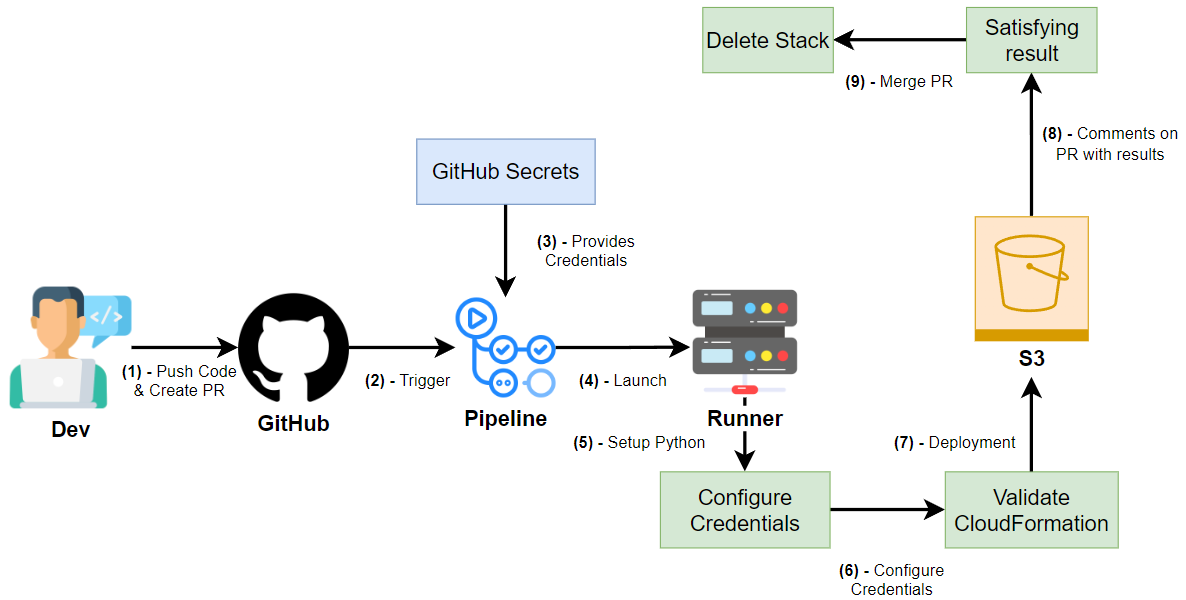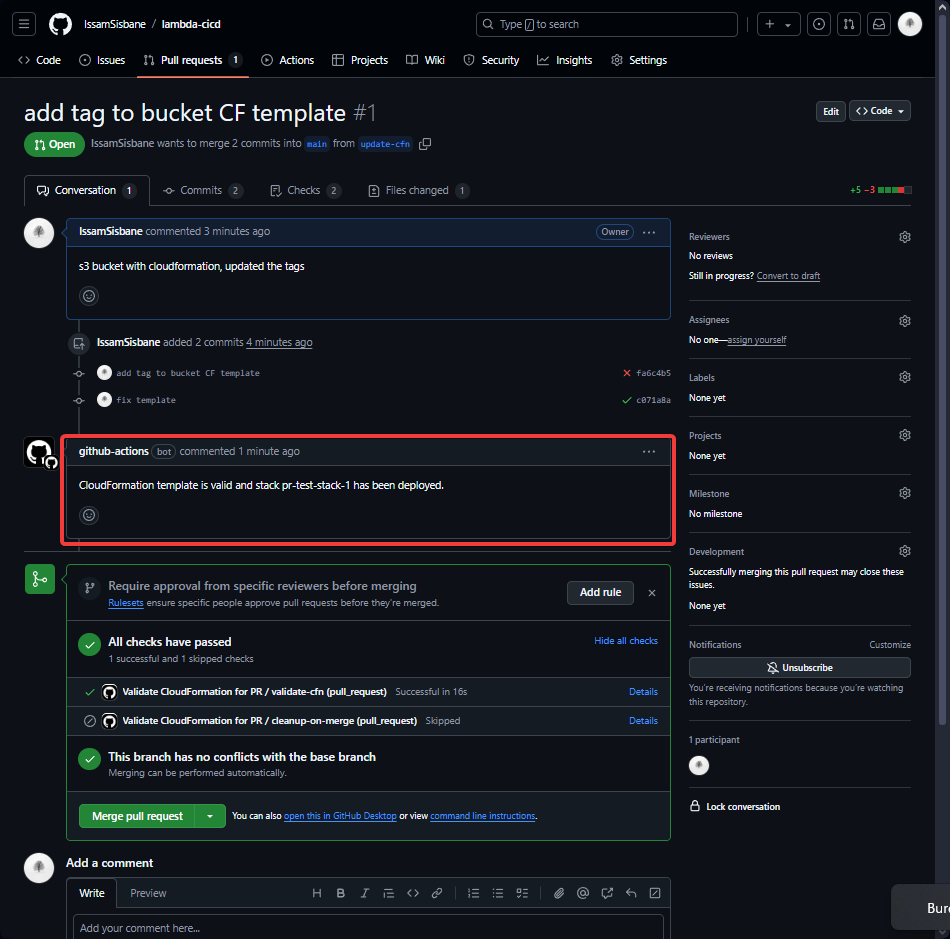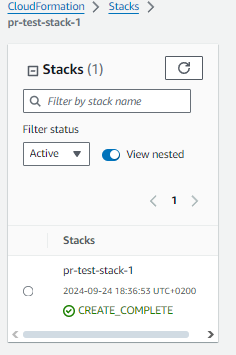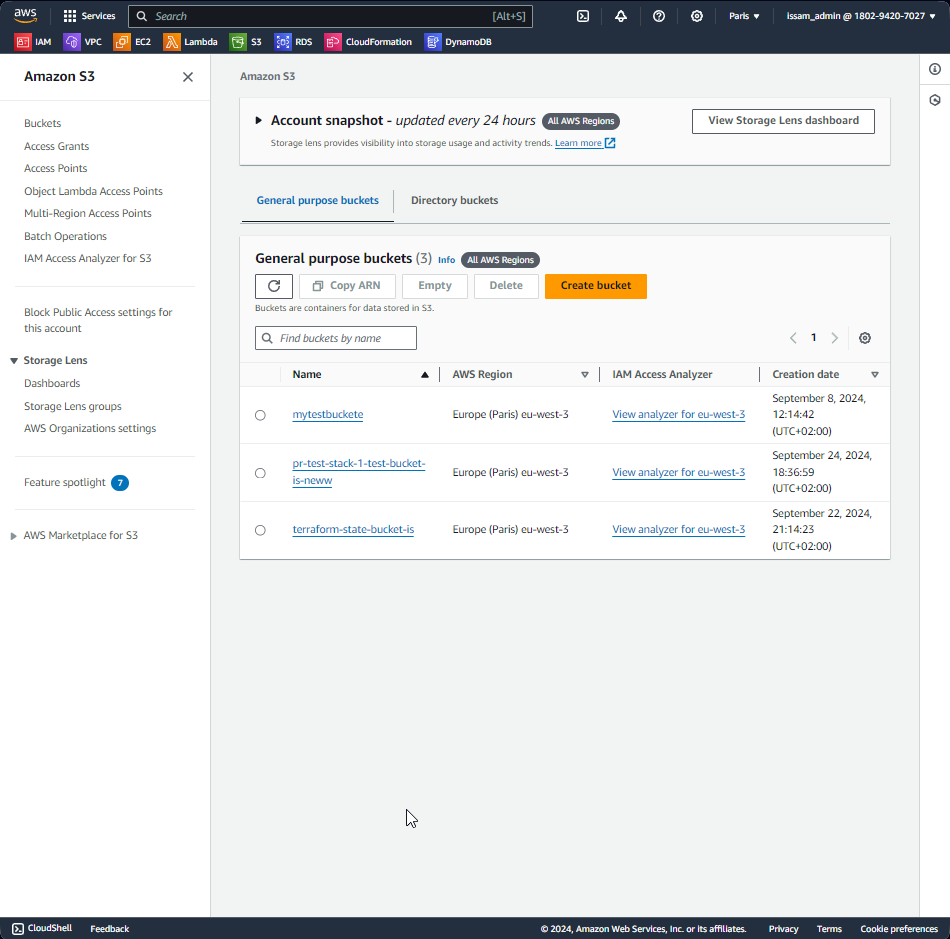
Testing IaC CloudFormation Template using GitHub Actions
This project allow me to learn a lot. Indeed, it was interesting to see how we can validate IaC before merging to the main branch. I never thought of this way before. The project code can be found here.
1 — Overview
2 — Steps
3 — Conclusion
1 - Overview
This project is focused on creating a GitHub Actions Workflow that automates the process of creating an S3 bucket using a CloudFormation template and testing it within a Pull Request (PR). The goal is to validate if the CloudFormation template is correctly written and functional before merging the PR into the main branch.

- Once the developer creates a pull request to merge into the main branch, the workflow will:
- Use the CloudFormation template to create an S3 bucket.
- Post the result of the CloudFormation operations in the PR discussion, along with the bucket name.
- Upon merging the PR, the workflow will delete the stack (and the S3 bucket), cleaning up the resources.
This workflow allows us to test the CloudFormation code within the pull request before it’s merged into the main branch. It ensures that the infrastructure code is working properly and prevents errors from being deployed in production.
In a production environment, a separate workflow triggered on the main branch would handle deploying the stack to the production environment.
We will be using the GitHub repository as our previous project.
2 - Steps
Step 1: Creating a Pull Request
Once a new branch is created, the developer will create a pull request (PR). This triggers the workflow to start, which will attempt to create an S3 bucket using the provided CloudFormation template.
Step 2: Error Handling
During the first run of the workflow, an error was detected in the CloudFormation template due to incorrect indentation.

- The error logs indicated a problem in the template’s structure, and after fixing the indentation issue, the workflow was triggered again.
Step 3: Successful Validation and Creation
After correcting the error, the pipeline executed smoothly. The S3 bucket was successfully created, and the PR discussion was updated with the validation results, including the name of the bucket created.

- CloudFormation Stack created successfully:

- S3 Bucket created as expected:

Step 4: Cleanup Process Fails to Trigger
However, we noticed that after merging the pull request, the cleanup job (responsible for deleting the stack and the S3 bucket) did not run. To resolve this, we had to update the workflow configuration.
Step 5: Workflow Configuration Update
To fix the issue and ensure that the cleanup job runs after merging the PR, we added the following configuration to the workflow file:
on:
pull_request:
paths:
- "cloudformation/**"
types: [opened, synchronize, reopened, closed]
This ensures that the workflow triggers on specific PR events (opened, synchronized, reopened, and closed) and only for files in the cloudformation/ directory.
Step 6: Preventing the Validation Job from Running on Merge
Additionally, we updated the validate-cfn job to avoid running the CloudFormation validation when the PR is merged. We added the following condition to skip this step when the PR is merged:
jobs:
validate-cfn:
if: github.event.pull_request.merged == false
This ensures that the validation job only runs for unmerged PRs, preventing unnecessary execution after the code is already merged.
Step 7: Successful Cleanup Job Execution
After applying the fixes, the workflow executed correctly, and the cleanup job successfully ran after merging the PR. The stack and S3 bucket were deleted as expected.

Finally, everything worked as intended, and the resources were cleaned up once the pull request was merged. After creating a new branch and create a pull request, our workflow started and found an error in our Cloudformation template.
3 - Conclusion
This project showcases the power and flexibility of GitHub Actions when combined with CloudFormation for automating infrastructure tasks. By integrating this workflow into the development process, we can:
- Validate infrastructure code within pull requests.
- Ensure infrastructure correctness before merging into the main branch.
- Automatically create and delete resources, keeping the environment clean.
In a real production environment, we would likely use a more robust deployment strategy with separate workflows for staging and production environments, ensuring a smooth and reliable infrastructure deployment process.
This setup also demonstrates how automating infrastructure validation and cleanup processes can help ensure that infrastructure changes are safe, repeatable, and manageable across different environments.
It was interesting to see how we can validate IaC before merging to the main branch. I never thought of this way before.